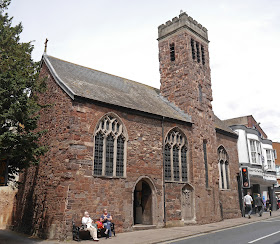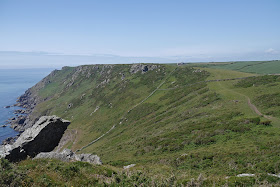Exeter Cathedral
After three wonderful but tiring days of walking along the coast path, we decided to have a look at Exeter on our way home. I had found various themed walks on the City Council's website, but none of them printed out very clearly and so we improvised a single all-purpose walk. We started from the Cathedral and Quay car park (as being the most convenient for continuing our journey home) and began by walking to Magdalen St to see the Wynard's Almshouses (almshouses are a special interest of mine). They date from 1453, but seem to have been rebuilt in 1863 (Pevsner) and make a handsome group.
Now we walked briefly along South St past where the South Gate once stood and followed a path by the city walls. The walls are apparently 70% complete and date originally from Roman times, with further developments in the Saxon, Norman and Medieval periods.
At the end of this section of wall, there is a delightful walkway over Cathedral Close. The gap was cut into the wall in 1754, when a tower was removed, and the bridge was built by the then mayor in 1814.
The Cathedral Close is is, as a result of wartime damage, more open than would be typical. The right hand side contains a very pleasant group of 18th century buildings.
At the end is the splendid Mol's Coffee House building which dates from the early 16th century, although it bears the date 1596. The Dutch gable is a late Victorian addition. To its left is the 15th St Martin's church, now redundant. The tower was added in 1675.
We admired the great Norman towers of the Cathedral, which date from the early 12th century and are arranged in an unique way, one each side of the nave. We then went round to see the facade, which like most of the rest of the cathedral is 14th century, but it is at the moment mostly hidden behind scaffolding, hence this truncated picture.
We walked up Catherine St towards the area which suffered the most bomb damage in the second world war. On the right are the ruins of St Catherine's Almshouses (1458) and St Catherine's Chapel and Canon's house.
From here we headed across to Exeter Castle and admired the Norman Gatehouse of Rougemont castle, as the original castle was called, after the local red sandstone from which it was built. It dates from 1068 and has the surprising distinction of being the oldest standing castle building in Britain.
We walked through the very pleasant Rougemont Gardens and round the side of the Royal Albert Memorial Museum, an impressive building of 1868 by west country architect John Hayward.
Now into the High St, where we enjoyed this pair of, presumably late-Victorian, elevations.
We now headed south down the High St in search of the Guildhall. It dates from 1468, but the part which projects on columns over the street was the result of a re-modelling in 1592. Pevsner describes it thus: "as picturesque as it is barbarous", but most others seem to focus on the picturesque.
High St leads into Fore Street , where we passed the unusual 14th century St Olave's church ...
... and then turned right to find St Nicholas Priory.
This is a bit of a misnomer as all that remains of the Benedictine Priory, said to have been founded in 1080, is the odd-looking guest wing. The culprit in this case was Henry VIII and his Dissolution of the Monasteries, beginning in 1536.
Finally, we headed towards the Quay, which seems to have been nicely modernised.
The Customs House of 1681 was the most impressive building.
We were now of course close to the Cathedral and Quay car park, so we repaired there and continued our journey home.
Conditions: warm, but cloudy.
Distance: about 3 miles.
Rating: four stars.



























































